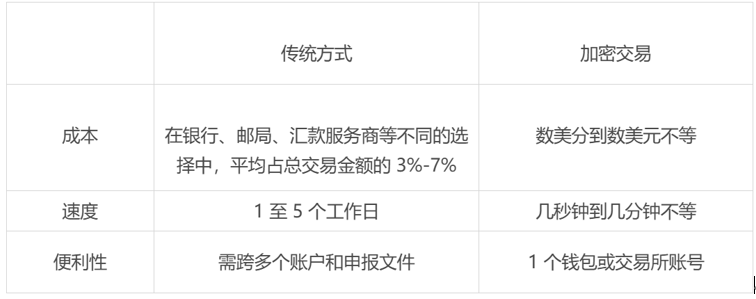在全球一体化进程不断加速的时代背景下,跨境支付无疑已经成为国际贸易、汇款和商业运营的命脉。然而传统金融体系在满足快速数字化世界的需求方面却显得力不从心,面临诸多困局,一方面,高昂的交易成本让众多企业和个人望而却步,增加了全球经济活动的负担;另一方面,漫长的结算时间也严重影响了资金的流转效率,使得商业活动的节奏受到极大制约;此外复杂的监管障碍也给跨境支付带来诸多不确定性,阻碍了国际贸易的顺畅进行。
风物长宜放眼量,随着全球贸易需求的加速膨胀,市场迫切需求更灵活、更具成本效益且技术先进的解决方案,在此背景下,基于數字货币的跨境支付手段自然而然地浮出水面,有望彻底颠覆传统跨境支付模式,为现代国际贸易带来全新的变革。
传统跨境支付的困境
在传统跨境支付中,由于整个流程中涉及涉及多家代理银行,流程繁琐且多步骤,使得结算时间可能延长至数天(T+N),而在实时交易逐渐成为常态的当下,这无疑造成了巨大的效率浪费。
其次,参与交易的每一家中间银行都会收取费用,这大大增加了汇款人的总成本,对于依赖及时付款以有效管理现金流的企业以及向跨境家庭成员汇款的个人来说,这些延迟和费用几乎难以承受。
再者,不同司法管辖区的监管环境复杂多样,因此多家处于全球各地的中间银行也给传统跨境支付带来了挑战,在漫长的交易期间,汇率波动的不可测风险进一步加剧了这些困境。
总之,传统金融银行间支付流程存在诸多问题,市场迫切需要能够提供更快、更具成本效益且更可靠的跨境支付选项的创新解决方案,以支持全球贸易的速度和规模。
数字资产:全球金融交易的变革者
在全球一体化进程不断加速的时代背景下,跨境支付无疑已经成为国际贸易、汇款和商业运营的数字资产和区块链技术越来越被认为是应对这些挑战的可行解决方案。
首先,通过实现实时结算并消除对中介机构的需求,基于区块链的支付大大降低了交易成本并提高了跨境交易的整体效率——不仅减少了延迟,还解决了与传统金融系统相关的复杂性和高成本问题,使企业和个人都能更方便地进行跨境支付,并提高其可靠性。

从上图中可以明显看出,数字资产在成本和速度方面比传统支付系统具有显著优势,它通过直接在各方之间处理支付,消除了对中介机构的需求,从而大大降低了交易费用,节省了大量成本。
此外,它们能够实现近乎即时的跨境转账,与基于多家代理银行的传统跨境支付系统相比有了显著改进——传统模式下大家可能需要几天时间才能完成结清算。
更值得注意的是,数字资产通过在传统银行基础设施有限或不存在的地区提供金融服务来增强金融包容性,尤其使新兴市场受益,这种便利性和效率也使数字资产成为企业和个人越来越有吸引力的选择。
大风起于青萍之末,数字化驱动的跨境支付解决方案已经开始通过提供更快、更便宜、更安全的跨境交易替代方法,来颠覆传统跨境支付渠道。
数字支付的新兴格局
正因如此,在 Money20/20 等近期活动中,跨境支付已然成为讨论的核心话题,行业领导者都开始聚焦于这一不断发展的新格局所带来的挑战和机遇。
其中,跨境交易的复杂性在新兴市场(如亚洲)表现得尤为突出,预计到 2023 年,数字钱包的使用将占据所有数字支付交易的 58% 以上。不过尽管数字创新迅速被采用,但 Payoneer 董事总经理 Jody Perla 强调,跨境交易仍然复杂且成本高昂,这凸显出持续改进跨境交易支付手段以满足现代全球贸易需求的紧迫性。
随着这些趋势的不断发展,越来越多的支付公司将数字支付视作一种有效的解决方案。例如 PayPal Ventures 已投资数字支付初创公司 Mesh,表明数字资产作为金融服务变革力量的认可度持续提升。PayPal Ventures 合伙人 Amman Bhasin 阐述了这一愿景,他表示:「随着金融服务领域快速转型,我们相信资产的用户所有权和可携带性将成为产品创新的关键基石,而数字资产将成为实现这一目标的第一个滩头阵地。」
世界银行也认识到,数字资产如稳定币等在解决现有货币体系挑战方面的应用日益增多,特别是在新兴市场和发展中经济体(EMDEs),这些数字资产被视为在传统金融基础设施缺乏的地区增强金融包容性和提高跨境支付效率的关键工具。
与稳定资产(如美元)挂钩的稳定币的使用,在减轻与货币波动相关的风险方面也起着至关重要的作用,这确保了交易的稳定价值,使其对企业和个人来说更加可靠。
且稳定币的采用率在几个关键指标上显而易见:截至 2024 年 5 月,有超过 2750 万活跃用户,反映出交易量同比增长 50%,此外现在约有 30% 的全球汇款是通过稳定币促成的。这种日益增长的接受度凸显了一个更广泛的趋势,即企业和消费者越来越多地转向數字驱动的解决方案,以解决传统跨境支付系统的低效率和局限性。
随着金融格局的不断演变,数字资产有望在塑造跨境结算和全球金融的未来方面,发挥更加关键的作用。
跨越传统与數字的鸿沟:OSL 场外交易服务
OSL 作为香港持牌合规的数字资产服务企业,正屹立于这一具有历史意义的科技趋势前沿,致力于通过提供连接数字资产与传统银行系统的服务,将數字货币与传统方法的优势完美结合。
其中 OSL 场外交易服务是主要抓手,它的关键特征便是坐拥强大的银行关系,特别是与香港主要银行的紧密合作,使得结算时间能够大大压缩 —— 这对于数字金融尤为重要:
与传统金融系统中跨境交易可能需要数天时间不同,OSL 利用先进的区块链技术和银行网络,能够实现近乎即时的结算。
这种速度对于需要在不同市场快速执行大规模交易的机构客户至关重要,确保资金在全球范围内快速安全地转移,与此同时 OSL 遵守严格的 KYC(了解你的客户)和 AML(反洗钱)标准,增添了额外的安全层级与信任度。
值得注意的是,速度是 OSL 场外交易服务的基石,但远非其唯一优势。由于 OSL 目前是香港唯二的持牌交易所,因此其在监管合规和安全方面也树立了新的行业标杆——作为一直领航经营受监管交易所和全面保险覆盖的数字资产平台,OSL 获得了 SOC 2 Type 2 认证以及由知名会计师事务所进行的定期审计,确保了客户资产具有最高级别的安全性。
与此同时,OSL 的场外交易服务也可提供市场最佳的深度流动性,促进大宗交易的低摩擦无缝执行,其中它通过其先进的 REST API 和询价(RFQ)系统支持多种交易选项,使客户能够高效交易并获得有保证的报价,消除了传统交易所经常出现的场内价格滑点风险。
此外,OSL 的定制客户服务和战略性全球合作伙伴关系,也使其能够满足其在全球主要市场的多样化客户不断变化的需求。
随着数字经济的不断发展,数字支付在革新金融交易中的作用愈发显著,尤其是随着对跨境转账的速度、安全性和效率的需求持续增长,数字资产有望成为全球金融基础设施的基石。
而站立潮头、引领变革的创新者,无疑需要融合传统金融与數字交易的特性,正如 OSL 场外交易服务巧妙地将数字资产的优势与传统银行的可靠性无缝融合,从而通过提供快速、安全且合规的解决方案,确保客户能够在充满活力的数字经济中蓬勃发展。
未来已来,传统金融与數字交易的融合,或将为全球金融体系注入新的活力。
*注:本文所表达的观点和意见仅代表作者本人,并不必然反映 OSL 集团有限公司或其联属公司的观点或立场。此处包含的任何预测及意见仅作为一般市场评论,不构成证券或投资要约,也不构成要约邀请、建议、投资意见或保证回报。此处包含的信息、预测和意见均截至本文日期,如有变更,恕不另行通知,且不应被视为任何投资产品或市场建议。
免责声明:本文章仅代表作者个人观点,不代表本平台的立场和观点。本文章仅供信息分享,不构成对任何人的任何投资建议。用户与作者之间的任何争议,与本平台无关。如网页中刊载的文章或图片涉及侵权,请提供相关的权利证明和身份证明发送邮件到support@aicoin.com,本平台相关工作人员将会进行核查。




